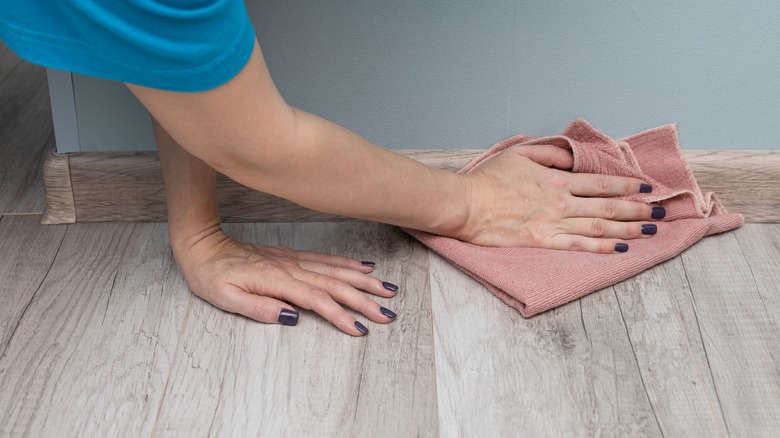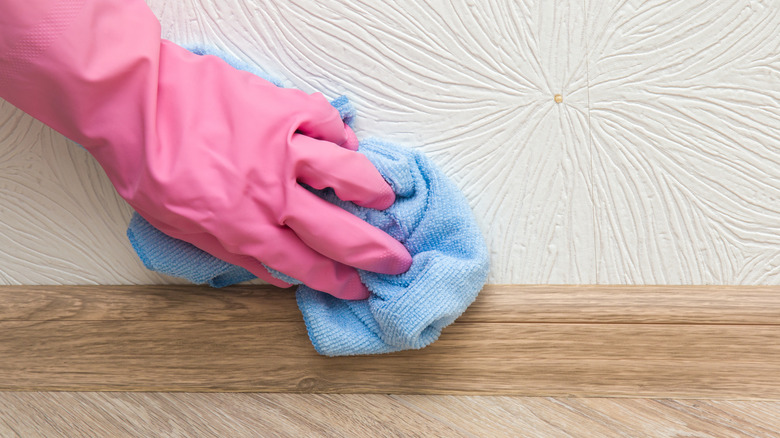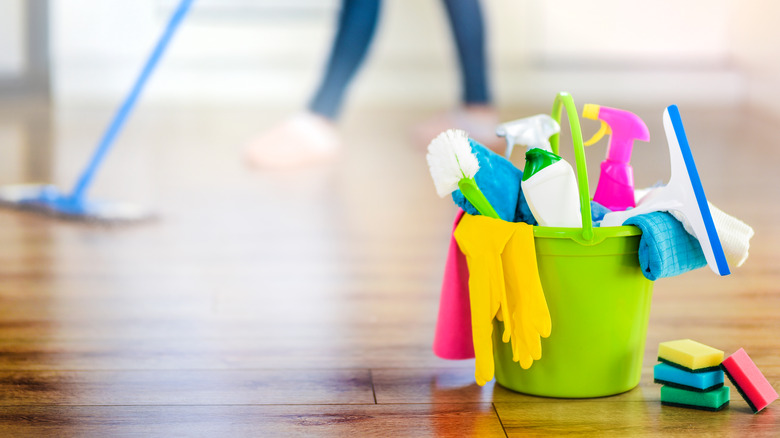Is WD-40 The Secret To Reviving Scuffed Up Baseboards?
In a busy home, baseboards can easily become scuffed up. One common cause is accidental contact with furniture, vacuum cleaners, or other household items. When moving furniture or cleaning, it's easy for the baseboards to get scratched or dented. Another factor is regular wear and tear over time, as people may accidentally kick or bump into the baseboards while walking around the house. Paired with these accidents, improper cleaning techniques or the use of harsh cleaning products can also contribute to scuff marks on baseboards. Nevertheless, it's important to tend to these easily overlooked sections of the home in order to keep them clean and lengthen their lifetime. One useful resource you likely already have at home that can easily revive your baseboards is a can of WD-40.
WD-40 is great at removing scuffs from baseboards because of its unique formula and properties. It contains solvents that help to break down and dissolve dirt, grime, and residue that may be causing the marks. The lubricating properties of WD-40 also make it easier to gently scrub and lift the scuffs without damaging the baseboard's surface. Its versatility and effectiveness in removing various types of stains and marks make it a popular choice for cleaning and restoring baseboards. So if you've got a dirty baseboard that needs a tune-up, all you need to restore it to a sparkling shine may be a can of WD-40, a soft cloth, and a bit of elbow grease.
How to use WD-40 to remove baseboard scuffs
To use WD-40 to remove scuffs from baseboards, start by shaking the can well to ensure that the product is properly mixed and ready to use. This will help to activate the ingredients and maximize their effectiveness. Hold the can of WD-40 about 6-8 inches away from the scuffed area of the baseboard. Spray a small amount of WD-40 directly onto the scuff mark, being careful not to overspray or saturate the area.
Allow the WD-40 to sit on the scuff mark for a few minutes to let it penetrate and loosen the dirt or residue. After letting the WD-40 sit, take a soft cloth or a non-abrasive sponge and gently scrub the scuff mark in a circular motion. Apply light pressure to avoid damaging the baseboard. The WD-40 should help to lift the mark and make it easier to remove.
Once the scuff mark is gone, use a clean cloth or sponge to wipe away any remaining WD-40 from the baseboard. This will help to prevent any greasy or sticky residue from attracting dirt or dust. If the mark is stubborn and doesn't come off completely, you can repeat the process by spraying the area with WD-40 again and gently scrubbing until the blemish is fully removed. Finally, use a clean, dry cloth to buff the baseboard and restore its shine. This will help to remove any remaining residue and leave the surface looking clean and refreshed.
Cautions in using WD-40
While WD-40 can be effective in removing scuffs from baseboards or floors, there are some precautions to keep in mind when using this product. First, it is important to test the process on a small, inconspicuous area of the baseboard before applying it to the scuff mark. This is to ensure compatibility and avoid any potential damage to the baseboards, as some may have a sensitive or delicate finish that could be affected by the chemicals in WD-40.
Additionally, it is crucial to avoid overspraying or saturating the area with WD-40. Excessive use of the product can lead to damage or discoloration of the baseboard or surrounding surfaces. It is recommended to spray a small amount of WD-40 directly onto the scuff mark and use a soft cloth or sponge to gently scrub the area.
Furthermore, WD-40 is not suitable for all types of baseboards. For example, if the baseboards are made of unfinished wood or have a waxed or oiled finish, using WD-40 may not be a good idea as it can penetrate the wood and cause discoloration or damage. In such cases, it is advisable to consult the manufacturer's guidelines or seek alternative cleaning methods.
Alternatives to using WD-40 for removing scuffs from baseboards include using a magic eraser, a mixture of baking soda and water, or a mild detergent solution. These options are generally safe for most types of baseboards and can effectively remove scuff marks without causing damage.


